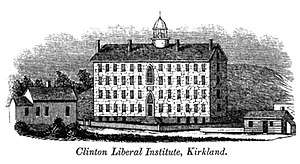Clinton Liberal Institute
The Clinton Liberal Institute was a coeducational preparatory school established by the Universalist Church in the village of Clinton, in the Town of Kirkland, New York, in 1831, relocated to Fort Plain, New York in 1878, and remaining there until its buildings were destroyed in a fire in 1900.

History
Efforts by the Universalist Church to establish a non-denominational school in the State of New York began in 1831.[1] The intent of these efforts was to create a school "not only for general purposes of science and literature, but with a particular view of furnishing with an education young men designed for the ministry of reconciliation", due to the perception that other Christian schools that dominated the state were "hostile to the doctrine" of Universalism.[1] To this end, the Clinton Liberal Institute was established in Clinton, New York, and the first students were admitted in November 1831.[1] On April 29, 1834, the New York State Legislature passed a bill entitled "AN ACT to incorporate the Clinton liberal institute", formally allowing a group of eighteen trustees to create "The Clinton Liberal Institute" as a body "for the purpose of providing a literary seminary for the public instruction and education of youth."[2]
The original building of the Institute was four stories tall (plus a basement), with a base 96 by 52 feet, built of gray stone. A separate wooden building for classes for women was two stories tall, and 40 by 25 feet. The school was placed under the visitation of the Regents of nearby Hamilton College in 1836.[3]
In 1845, after much discussion within the Universalist Church about establishing a seminary in the state of New York, Reverend Thomas J. Sawyer—a leading proponent of such an establishment—took charge of the Clinton Liberal Institute. He set aside two hours per day to lecture on theology to any students who wanted to attend, at no cost to the students. He continued to offer this additional instruction until the fall of 1853, by which time efforts were underway to open a Universalist seminary elsewhere in New York. Sawyer prepared a total of 37 students to enter the ministry during this period.[1]
In 1878, the Institute was relocated from Clinton to the facilities of the former Fort Plain Female Seminary and Collegiate Institute in Fort Plain, New York.[4][1] In 1891, the Institute established a military academy (with both male and female cadets) as part of the school,[5][6] and had an armory for the storage of artillery equipment.[6] All of the Institute's buildings at the Fort Plain location were destroyed in a fire on March 25, 1900.[7][6] The Institute's "remaining resources were then transferred to Canton, New York, and merged with the theological school of St. Lawrence University."[7]
Associated individuals
Notable alumni include:
- Adolphus C. Bartlett, industrialist[8]
- Clara Barton, founder of the American Red Cross[9]
- William Biddlecome, attorney and politician[10]
- Winchester Britton, attorney and politician[11]
- Matilda Joslyn Gage, suffragist[12]
- Francis H. Gates, politician[13]
- Jeremiah Keck, lawyer and politician[14]
- Philip Keck, lawyer, judge, and politician[15]
- Simon Lake, inventor of the modern submarine[6]
- Jervis McEntee, painter[16]
- Charles R. Skinner, U.S. Representative[17]
- Charles Stanford, merchant, newspaper publisher and politician[18]
- Leland Stanford, Governor of California, U.S. Senator, and founder of Stanford University[9]
- Farris B. Streeter, Solicitor of the United States Treasury[19]
- George E. Williams, newspaper publisher and politician[20]
Other notable people connected to the Institute include Caroline Soule, an American novelist, poet, religious writer, who was employed for two terms (seven months), without pay, as the principal of the female department.[21]
References
- Joseph Henry Allen, Richard Eddy, History of Universalism, p. 486-490.
- Laws of the State of New York: Passed at the Fifty-Seventh Session of the Legislature (1834), p. 364.
- John Warner Barber, Henry Howe, Historical Collections of the State of New York (1842), p. 362.
- "The Clinton Liberal Institute :: Fort Plain Free Library". nyheritage.nnyln.net.
- United States. War Department, Annual Report of the Secretary of War (1892), p. 270.
- "Clinton Liberal Institute". New York Heritage. Archived from the original on August 3, 2017. Retrieved August 3, 2017.
- Clinton Lee Scott, The Universalist Church of America: A Short History (1957), p. 76.
- Daniel Stern, American Artisan (1922), Vol. 83, p. 21.
- "Our History – Clinton, NY". www.clintonnychamber.org.
- 'Proceedings of the State Bar Association of Wisconsin,' vol. 1, 1905, Biographical Sketch of William Biddlecome, pg. 193
- Lucien Brock Proctor, The Bench and Bar of King's County, N.Y. and the Bench and Bar of the City of Brooklyn (1884), p. 105;
- White, J.T. (1921). The National Cyclopaedia of American Biography (Public domain ed.). J.T. White. p. 244.
- The New York Red Book by Edgar L. Murlin (1903; pg. 77f).
- 'Who's Who In New York State And City,' L. R. Hamersly-editor, L. R. Hamersly Company, New York City: 1905, Biographical Sketch of Jeremiah Keck, pg. 499
- 'New York State Bar Association-Proceedings of the Thirty-Fifth Annual Meeting, January 19–20, 1912, The Argus Company, New York City: 1912, Biographical Sketch of Philip Keck, pg. 575–576
- "Jervis McEntee Diary, 1844–1845". Finding Aids. Syracuse University Libraries. Retrieved 21 August 2013.
- United States Congress, "Charles R. Skinner (id: S000467)", Biographical Directory of the United States Congress.
- Life Sketches of the State Officers, Senators, and Members of the Assembly of the State of New York, in 1867 by S. R. Harlow & H. H. Boone (pg. 144ff).
- Courts and Lawyers of Pennsylvania: A History, 1623–1923, by Frank Marshall Eastman, Volume 3, 1922, p. 678.
- The State Government for 1879 by Charles G. Shanks (Weed, Parsons & Co, Albany, 1879; p. 166).
- Dictionary of Unitarian and Universalist Biography, Caroline Soule